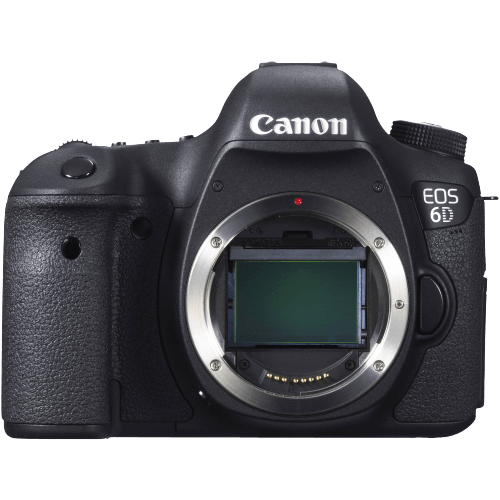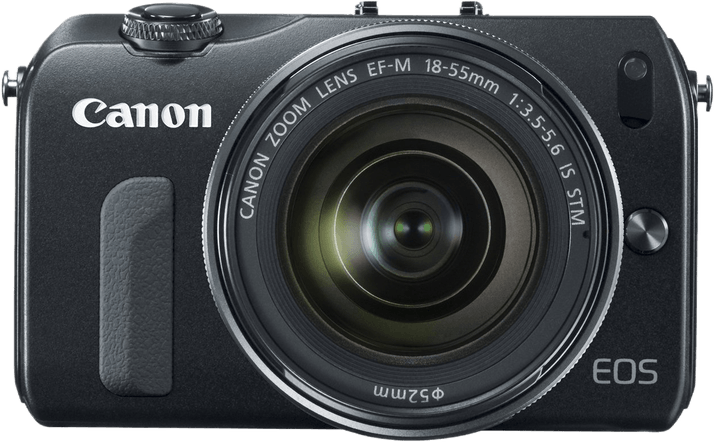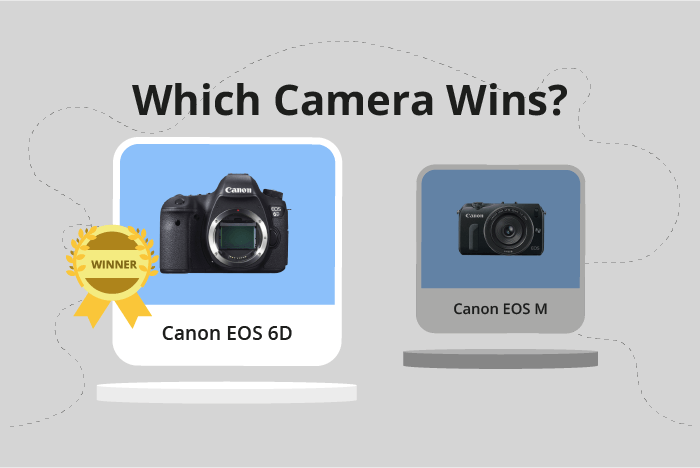Canon EOS 6D vs EOS M Comparison
Canon EOS 6D

Canon EOS M

The Canon EOS 6D outperforms the Canon EOS M with a score of 59/100 compared to 44/100. Both cameras share the same announcement year (2012) and manufacturer (Canon). The EOS 6D, a DSLR, excels with its larger size (145 x 111 x 71mm) and heavier weight (770g / 1.70lbs), offering more stability and durability. Its higher launch price of $2099 reflects its superior quality.
On the other hand, the EOS M, a mirrorless camera, boasts a more compact size (109 x 66 x 32mm) and lighter weight (298g / 0.66lbs), making it easier to carry and ideal for casual photography. Its lower launch price of $799 makes it a more affordable option.
Taking these factors into account, the Canon EOS 6D proves to be the better camera in terms of performance and durability, while the Canon EOS M offers a more portable and budget-friendly alternative.
Canon EOS 6D vs EOS M Overview and Optics
The Canon EOS 6D outperforms the Canon EOS M in optics with a score of 61/100 compared to the EOS M’s 42/100. Both cameras share some common specifications, including a CMOS sensor, Digic 5 series processor, and no image stabilization. However, there are distinct differences that make the EOS 6D the superior camera in terms of optics.
The EOS 6D boasts a higher megapixel count at 20.2 compared to the EOS M’s 18 megapixels. This higher resolution allows for more detailed images and better quality when cropping or enlarging photos. Additionally, the EOS 6D has a faster shooting speed of 4.5 frames per second (fps) compared to the EOS M’s 4.3 fps. This slight advantage can be crucial for capturing fast-moving subjects or action shots.
One of the most significant differences between the two cameras is the sensor size. The EOS 6D features a full-frame sensor, while the EOS M has an APS-C sensor. The larger sensor in the EOS 6D provides better low-light performance, increased dynamic range, and shallower depth of field. Furthermore, the EOS 6D has a higher DXOMARK score for its sensor at 82, compared to the EOS M’s score of 65, indicating superior image quality.
The EOS M has a smaller and lighter body, making it more portable and convenient for travel or everyday use. It also utilizes the Canon EF-M lens mount, designed specifically for the EOS M series, offering a selection of compact and lightweight lenses.
To sum up, the Canon EOS 6D is the clear winner in optics, providing higher resolution, faster shooting speed, and better image quality with its full-frame sensor. The EOS M, while inferior in terms of optics, offers a more compact and lightweight design, making it a suitable choice for those prioritizing portability.
Canon EOS 6D vs EOS M Video Performance
The Canon EOS 6D and Canon EOS M both have a video score of 43/100, indicating that their video capabilities are evenly matched. These cameras share several video specifications, including Full HD video resolution, max video dimensions of 1920 x 1080, and a max video frame rate of 30fps. Additionally, neither camera has built-in time-lapse functionality.
Despite the identical scores, the Canon EOS 6D has some advantages over the Canon EOS M. As a full-frame camera, the EOS 6D provides better low-light performance and a shallower depth of field, which can be beneficial for certain video applications. Furthermore, the EOS 6D has a larger sensor, which contributes to improved overall image quality in video recordings.
On the other hand, the Canon EOS M is a mirrorless camera, making it more compact and lightweight than the EOS 6D. This can be an advantage for videographers who prioritize portability and ease of use. Additionally, the EOS M may offer faster autofocus in video mode, as mirrorless cameras typically excel in this area.
Taking all factors into consideration, the Canon EOS 6D and Canon EOS M have similar video capabilities, with the EOS 6D offering better image quality due to its larger sensor, and the EOS M providing a more compact and portable option. Ultimately, the choice between these two cameras will depend on the specific needs and preferences of the videographer.
Canon EOS 6D vs EOS M Features and Benefits
The Canon EOS 6D and the Canon EOS M both have a feature score of 57/100. Despite having the same score, each camera has distinct advantages and disadvantages in their features.
Both cameras share some common specifications. They have a 3-inch screen size and a screen resolution of 1,040,000 dots. However, the Canon EOS M has a touchscreen, while the Canon EOS 6D does not. This feature makes the EOS M more user-friendly and convenient for quick adjustments.
The Canon EOS 6D outperforms the EOS M in connectivity. It has GPS and WIFI capabilities, while the EOS M lacks these features. GPS allows the 6D to geotag images, making it easier to organize and locate photos based on location. WIFI enables users to transfer images wirelessly and control the camera remotely through a compatible smartphone or tablet. The EOS 6D does not have Bluetooth, but its GPS and WIFI features make it a better choice for those who prioritize connectivity.
On the other hand, the Canon EOS M has a touchscreen, as mentioned earlier. This feature provides a more intuitive user experience, allowing users to navigate menus, review images, and adjust settings with ease. The EOS M does not have GPS, WIFI, or Bluetooth, but its touchscreen interface is its main advantage over the EOS 6D.
Taking these points into consideration, the Canon EOS 6D is the better choice for users who prioritize connectivity and location-based features, while the Canon EOS M is more suitable for those who prefer a more user-friendly touchscreen interface. Despite having the same feature score, each camera caters to different user preferences and needs.
Canon EOS 6D vs EOS M Storage and Battery
The Canon EOS 6D outperforms the Canon EOS M in storage and battery with a score of 45/100, while the EOS M scores only 13/100. Both cameras have one memory card slot and accept SD, SDHC, and SDXC cards. Neither camera supports USB charging.
The EOS 6D excels in battery life, providing 1090 shots per charge using the LP-E6 battery type. This is significantly longer-lasting than the EOS M’s 230 shots per charge that uses the LP-E12 battery type. This advantage makes the EOS 6D more suitable for extended shooting sessions.
The EOS M, however, does not have any advantages in storage and battery over the EOS 6D. Its lower score in this category is mainly due to its shorter battery life.
Considering the storage and battery aspects, the Canon EOS 6D is a better choice for photographers who require longer battery life for their shooting needs. The EOS M may be suitable for casual users who do not need extended battery life, but it does not offer any advantages in this category.
Canon EOS 6D vs EOS M – Our Verdict
Are you still undecided about which camera is right for you? Have a look at these popular comparisons that feature the Canon EOS 6D or the Canon EOS M:

